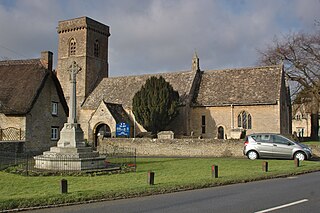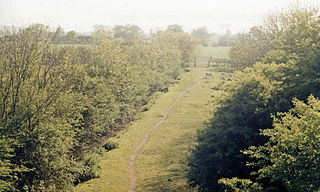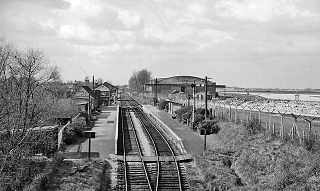
Carterton is a town in West Oxfordshire district in the county of Oxfordshire, England and is 4 miles (6.4 km) south-west of Witney. The 2011 Census recorded the parish's population as 15,769.

Brize Norton is a village and civil parish 1 mile (1.6 km) east of Carterton in West Oxfordshire. The 2011 Census recorded the parish population as 938. The original part of RAF Brize Norton is in the parish.

Alvescot is a village and civil parish about 1+1⁄2 miles (2.4 km) south of Carterton, Oxfordshire, England. The 2011 Census recorded the parish's population as 472.

Bampton, also called Bampton-in-the-Bush, is a settlement and civil parish in the Thames Valley about 4+1⁄2 miles (7 km) southwest of Witney in Oxfordshire. The parish includes the hamlet of Weald. The 2011 Census recorded the parish's population as 2,564. Bampton is variously referred to as both a town and a village. The Domesday Book recorded that it was a market town by 1086. It continued as such until the 1890s. It has both a town hall and a village hall.

Black Bourton is a village and civil parish about 2 miles (3 km) south of Carterton, Oxfordshire. The village is on Black Bourton Brook, a tributary of the River Thames. The 2011 Census recorded the parish population as 266. RAF Brize Norton adjoins the parish. The northern boundary of the parish is along the middle of the main runway of the airfield.

Winchcombe railway station is a heritage railway station which serves the town of Winchcombe in Gloucestershire, England. The stations itself is actually located in the nearby village of Greet. It is located on the Honeybourne Line which linked Cheltenham and Stratford-upon-Avon and which was opened by the Great Western Railway in 1906. The station closed to passengers in 1960, although the line itself remained open for freight and diversionary use until 1976, when a freight train derailed near Winchcombe and damaged the track.

Alvescot railway station was a railway station between the Oxfordshire villages of Alvescot and Black Bourton, in England. It was Oxford, Witney and Fairford Railway between Oxford and Fairford.
The Oxford, Witney and Fairford Railway was a single track railway branch line, 22 miles (35 km) long, in Oxfordshire and Gloucestershire. It was opened in succession by two companies, the first in 1861 to connect the important woollen town of Witney to the main line network, and the second in 1873 as the rump of an ambitious scheme to connect to Cheltenham, but which ran only between Witney and Fairford. The junction with the main line was at Yarnton, north of Oxford.

Olney was a railway station on the former Bedford to Northampton Line and Stratford-upon-Avon and Midland Junction Railway which served the town of Olney in Buckinghamshire, England. It was situated on a busy section of line between Towcester and Ravenstone Wood junction which saw heavy use by freight services running between Wales and north-east England. The station closed for passengers in 1962 and completely in 1964, the various connecting routes to the line having closed one by one from the 1950s onwards.

Cassington Halt was a single platform halt opened by the Great Western Railway on 9 March 1936 on the Oxford, Witney and Fairford Railway to serve the village of Cassington, Oxfordshire, just south of the A40.

Yarnton Junction was a three-platform station serving the village of Yarnton, Oxfordshire. It was built in 1861 at the junction of the Oxford, Worcester and Wolverhampton Railway and Witney Railway, north of Oxford. British Railways closed the station to passengers in 1962 and it was demolished c. 1965.

South Leigh railway station was a single-platform station that served the Oxfordshire village of South Leigh on the Oxford, Witney and Fairford Railway between Oxford and Witney. The Witney Railway opened the station in 1861. British Railways closed the station to passengers in 1962 and to goods in 1965.

Witney railway station served the Oxfordshire town of Witney on the Oxford, Witney and Fairford Railway line. It consisted of two stone-built platforms, a station building, a signal box, and a shed in the form of a pagoda.

Eynsham railway station served the Oxfordshire town of Eynsham and the Eynsham Sugar Beet Factory on the Oxford, Witney and Fairford Railway between Oxford and Witney.
Witney goods station served the Oxfordshire town of Witney on the Oxford, Witney and Fairford Railway. It consisted of seven sidings, a goods shed, a wooden parcel office and a cattle dock. It also had an engine shed, which was demolished early in the twentieth century. Following the opening of the East Gloucestershire Railway in 1873, the station became a goods depot, with passengers using the second station situated to the south. The original station remained open to goods traffic until 1970.

Brize Norton and Bampton railway station was a railway station 1 mile (1.6 km) south of the village of Brize Norton on the Oxford, Witney and Fairford Railway between Oxford and Fairford. The station had two stone-built platforms, a station building and a goods shed.

Kelmscott and Langford railway station was a railway station south of the village of Langford on the Oxford, Witney and Fairford Railway, between Oxford and Fairford.

Lechlade railway station served the small town of Lechlade in Gloucestershire, England. The station was on the Oxford, Witney and Fairford Railway, between Oxford and Fairford, it was built where the line crossed the road to Burford, 0.5 miles (0.80 km) north of Lechlade.

Fairford railway station served the town of Fairford in Gloucestershire. It was the western terminus of the Oxford, Witney and Fairford Railway between Oxford and Fairford. It had one platform, and a stone-built station building.
Wappenham was a railway station on the Stratford-upon-Avon and Midland Junction Railway (SMJ) which served the Northamptonshire village of Wappenham between 1872 and 1951. Serving a relatively rural area, the station saw considerable goods traffic generated by local farming communities, but passenger traffic was low which ultimately led to its closure.


















